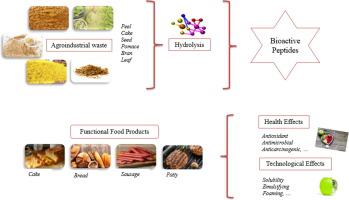Food Research International ( IF 8.1 ) Pub Date : 2020-07-02 , DOI: 10.1016/j.foodres.2020.109504 Ahmet Görgüç 1 , Esra Gençdağ 1 , Fatih Mehmet Yılmaz 1

|
Agro-industrial by-products including considerable amounts of protein (10 – 50%) such as soybean meal, rice bran and coconut pulp are promising bioactive peptide sources with annual disposal rate of 800 million tons in the world. More recently, plant by-products rich in protein content have been studied under various prisms that include recovery techniques, peptide production methods, determination of technological benefits and functional properties, and their applications in foods. The researches in bioactive peptides provide evidence over the techno-functional properties and the health benefits are highly dependent upon their amino acid sequences, molecular weights, conformations and surface properties. Research findings compared bioactive properties of the obtained peptides with respect to their amino acid sequences and also reported that hydrophobic/hydrophilic properties have direct effect on both functional and health effects. In addition, the resultant properties of the peptides could be affected by the conducted extraction method (alkaline, enzymatic, ultrasound assisted, microwave assisted, etc.), extraction solvent, precipitation and purification techniques and even by the final drying process (spray, freeze, vacuum, etc.) which may alter molecular weights, conformations and surface properties. Latest studies have investigated solubility, emulsifying, foaming, water/oil holding capacity and surface properties and also antioxidant, antimicrobial, anticarcinogenic, hypocholesterolemic, antihypertansive, immunomodulatory and opioid activities of bioactive peptides obtained from plant by-products. Moreover, the application of the bioactive peptides into different food formulations has been a recent trend of functional food development. These bioactive peptides’ bitter taste and toxicity are possible challenges in some cases that need to be resolved before their wider utilization.
中文翻译:

源自植物副产物的生物活性肽:食品开发中的生物活性和技术功能利用-评论。
包括大豆粉,米糠和椰子浆在内的大量蛋白质(占10%至50%)的农业工业副产品是有希望的生物活性肽来源,全球每年的处置量为8亿吨。最近,在各种方面对富含蛋白质含量的植物副产物进行了研究,包括回收技术,肽生产方法,技术优势和功能特性的确定及其在食品中的应用。生物活性肽的研究为技术功能特性提供了证据,而对健康的益处在很大程度上取决于其氨基酸序列,分子量,构象和表面特性。研究发现比较了获得的肽的氨基酸序列的生物活性,并报道疏水/亲水性对功能和健康都有直接影响。此外,肽的合成特性可能会受到所进行的提取方法(碱性,酶促,超声辅助,微波辅助等),提取溶剂,沉淀和纯化技术甚至最终干燥过程(喷雾,冷冻)的影响。 ,真空等),可能会改变分子量,构象和表面特性。最新研究调查了溶解度,乳化,起泡,保水/保油能力和表面特性,以及抗氧化剂,抗微生物剂,抗癌药,降胆固醇药,抗高脂药,从植物副产物获得的生物活性肽的免疫调节和阿片样物质活性。而且,将生物活性肽应用于不同食品配方中已经成为功能性食品开发的最新趋势。这些生物活性肽的苦味和毒性在某些情况下可能是挑战,需要在广泛应用之前加以解决。



























 京公网安备 11010802027423号
京公网安备 11010802027423号